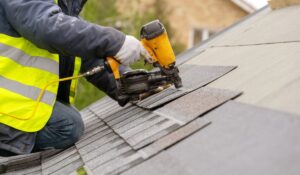The roof (or rooves) protects your home from rain, snow, sunlight, and extreme temperatures. It also provides a frame for other structures on the lot.

Metal roofing panels start out as coil, then are rolled into the desired profile/ribbing structure and assembled for installation. A metal roof requires layers of underlayment to prevent water from seeping through the surface. Visit https://www.topnotch-roofing.com/ for more information.
Roofing is one of the first layers of protection in a building, so its materials must be durable and meet various requirements, such as weather resistance. Whether you are building a new house or repairing an existing roof, there is a wide range of roofing materials from which to choose. Some of the most popular include shingles, metal, and membranes. The type of roofing material that is best for you will depend on your budget, as well as the climate in your region.
The type of framing you use for your roof will also have an impact on the overall look and cost. Choosing the right type of framing is crucial because it will help to keep your home protected and add value. Some common wood framing includes joists, tees, and keystone-shaped joists.
Another important consideration when choosing a roofing material is its lifespan. Some materials have a longer lifespan than others, and some are better suited for specific climates than others. If you are looking for a more long-term solution, consider installing a slate tile roof. This natural stone roofing is not only aesthetically appealing, but it also withstands extreme temperature fluctuations and high winds.
Rolled roofing is a more affordable option for low-slope roofs, and it consists of large rolls of asphalt material topped with mineral granules. Membrane roofing is an affordable alternative to rolled roofing and can be made from a variety of watertight materials such as neoprene, PVC, and the popular rubber EPDM.
A roof leak barrier is a crucial element to install underneath the lowest course of shingles in areas that get a lot of snow or rain. There are a number of options for this, including self-sealing modified bitumen sheeting and mineral-surfaced leak barriers like GAF WeatherWatch. This is especially important in areas with cold winters because it helps to prevent damage from ice dams and wind-driven hail.
Installation
Roofs protect buildings from rain, snow, sunlight, and extremes of temperature. They come in many forms, as dictated by technical, economic, or aesthetic considerations. Before committing to a roofing project, it’s best to hire a professional. If you’re concerned about the cost of hiring a contractor, check with your homeowners insurance company; they may recommend contractors in your area. Also, look for contractors who are credentialed by the manufacturer of the roofing materials you’re interested in using; they may have more training in installing that specific product.
Once the underlayment is in place, the contractor will start laying the shingles. A pattern of overlapping and nailing will be followed, with nails closer together around the edge of the shingle, then spread out more towards the center.
Maintenance
In order to protect against environmental and physical deterioration, roofing materials need to be regularly inspected and properly maintained. Routine inspections and maintenance procedures can minimize the time and expense of repairs, and provide early detection of problems such as moisture penetration and delamination of shingles or membrane.
Inspections and maintenance of roofing can be conducted by in-house building mechanics, or by qualified roofing professionals, depending on the extent of the work. A checklist of items to be examined can help to ensure that all pertinent areas are addressed. Typical maintenance procedures include:
* Replacing damaged or worn-out shingles and membrane.
* Checking and repairing the flashing (material that seals around roof penetrations, chimneys, skylights, etc) to prevent leaks.
* Cleaning the surface to remove dirt, debris and organic growth (moss, lichen, etc) that can degrade roofing materials.
* Clearing blocked drains, scuppers and gutters to facilitate drainage and reduce detrimental structural loading. Extreme caution should be taken when removing debris from a roof. Using scrapers or shovels can damage membranes and metal drain lines. Applying protective coatings and/or sealants to enhance durability, weather resistance and energy efficiency.
In order to perform these and other maintenance tasks, the crew will be equipped with a vehicle with all necessary tools and materials, and be briefed each morning on the specific needs of the buildings on that days schedule. In addition, the maintenance crew will be supplied with a roster of personnel that includes name, address, phone number and employer. We can also run background checks on the roster personnel if requested.
Repairs
A roofer can fix leaks, patch holes and repair the fascia and soffits. These are the horizontal boards that run under a roof’s overhang and support gutters. They also offer ventilation. If these are damaged or rotting, they can allow water and wind to enter a house. A professional can make these repairs quickly and cost effectively, and prevent further damage and larger disasters.
Re-roofing is an option for homeowners who want to cover a damaged roof but aren’t ready to pay for a complete replacement. However, it doesn’t protect against future damages and isn’t as durable as a full roof replacement.
Before re-roofing, a homeowner should do a careful inspection. This can be done from inside the attic or crawl space. Examine any exposed beams, stains and paint. Look for shingle overlays that are thinning, worn, or damaged. Any that can be replaced with new shingles as long as they match the existing ones. This will save thousands of dollars over a complete re-roofing. It’s a smart investment, but only for homeowners who can carefully assess their needs.